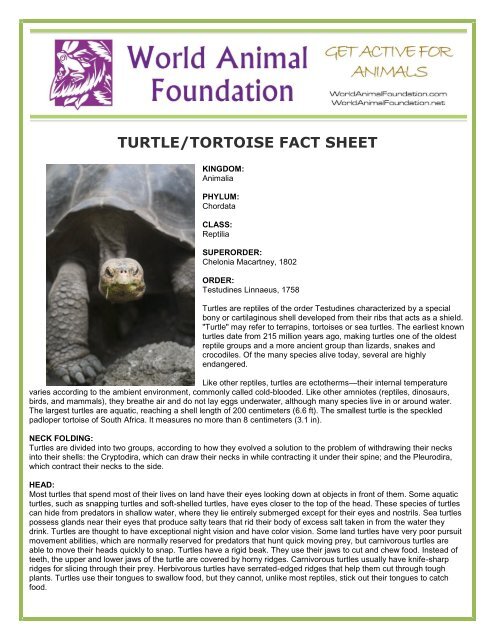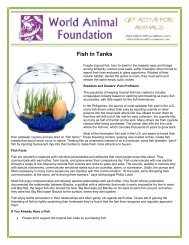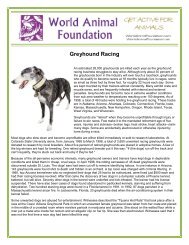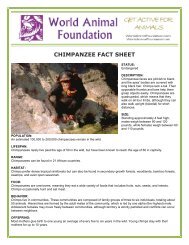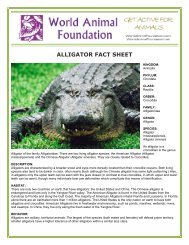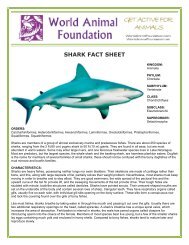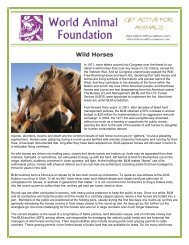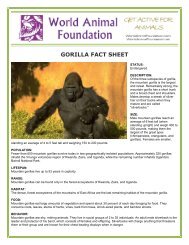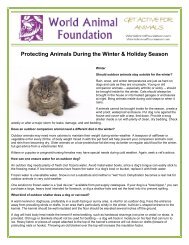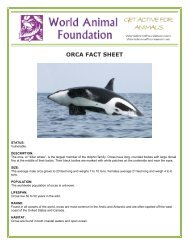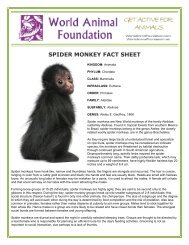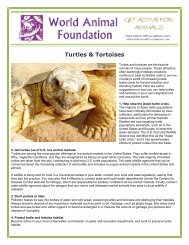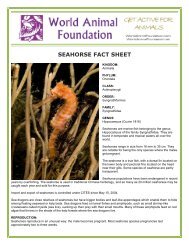TURTLE/TORTOISE FACT SHEET - World Animal Foundation
TURTLE/TORTOISE FACT SHEET - World Animal Foundation
TURTLE/TORTOISE FACT SHEET - World Animal Foundation
Create successful ePaper yourself
Turn your PDF publications into a flip-book with our unique Google optimized e-Paper software.
<strong>TURTLE</strong>/<strong>TORTOISE</strong> <strong>FACT</strong> <strong>SHEET</strong>KINGDOM:<strong>Animal</strong>iaPHYLUM:ChordataCLASS:ReptiliaSUPERORDER:Chelonia Macartney, 1802ORDER:Testudines Linnaeus, 1758Turtles are reptiles of the order Testudines characterized by a specialbony or cartilaginous shell developed from their ribs that acts as a shield."Turtle" may refer to terrapins, tortoises or sea turtles. The earliest knownturtles date from 215 million years ago, making turtles one of the oldestreptile groups and a more ancient group than lizards, snakes andcrocodiles. Of the many species alive today, several are highlyendangered.Like other reptiles, turtles are ectotherms—their internal temperaturevaries according to the ambient environment, commonly called cold-blooded. Like other amniotes (reptiles, dinosaurs,birds, and mammals), they breathe air and do not lay eggs underwater, although many species live in or around water.The largest turtles are aquatic, reaching a shell length of 200 centimeters (6.6 ft). The smallest turtle is the speckledpadloper tortoise of South Africa. It measures no more than 8 centimeters (3.1 in).NECK FOLDING:Turtles are divided into two groups, according to how they evolved a solution to the problem of withdrawing their necksinto their shells: the Cryptodira, which can draw their necks in while contracting it under their spine; and the Pleurodira,which contract their necks to the side.HEAD:Most turtles that spend most of their lives on land have their eyes looking down at objects in front of them. Some aquaticturtles, such as snapping turtles and soft-shelled turtles, have eyes closer to the top of the head. These species of turtlescan hide from predators in shallow water, where they lie entirely submerged except for their eyes and nostrils. Sea turtlespossess glands near their eyes that produce salty tears that rid their body of excess salt taken in from the water theydrink. Turtles are thought to have exceptional night vision and have color vision. Some land turtles have very poor pursuitmovement abilities, which are normally reserved for predators that hunt quick moving prey, but carnivorous turtles areable to move their heads quickly to snap. Turtles have a rigid beak. They use their jaws to cut and chew food. Instead ofteeth, the upper and lower jaws of the turtle are covered by horny ridges. Carnivorous turtles usually have knife-sharpridges for slicing through their prey. Herbivorous turtles have serrated-edged ridges that help them cut through toughplants. Turtles use their tongues to swallow food, but they cannot, unlike most reptiles, stick out their tongues to catchfood.
SHELL:The upper shell of the turtle is called the carapace. The lower shell that encases the belly is called the plastron. Thecarapace and plastron are joined together on the turtle's sides by bony structures called bridges. The inner layer of aturtle's shell is made up of about 60 bones that include portions of the backbone and the ribs, meaning the turtle cannotcrawl out of its shell. The shape of the shell gives helpful clues to how a turtle lives. Most tortoises have a large, domeshapedshell that makes it difficult for predators to crush the shell between their jaws. Most aquatic turtles have flat,streamlined shells which aid in swimming and diving. American snapping turtles and musk turtles have small, crossshapedplastrons that give them more efficient leg movement for walking along the bottom of ponds and streams. Thecolor of a turtle's shell may vary. Shells are commonly colored brown, black, or olive green. In some species, shells mayhave red, orange, yellow, or grey markings and these markings are often spots, lines, or irregular blotches. One of themost colorful turtles is the eastern painted turtle which includes a yellow plastron and a black or olive shell with redmarkings around the rim. Tortoises, being land-based, have rather heavy shells. In contrast, aquatic and soft-shelledturtles have lighter shells that help them avoid sinking in water and swim faster with more agility.SKIN AND MOLTING:Turtles do not molt their skins all at once, as snakes do, but continuously, in small pieces. Tortoises also shed skin, but alot of dead skin is allowed to accumulate into thick knobs and plates that provide protection to parts of the body outsidethe shell. By counting the rings it is possible to estimate the age of a turtle.LIMBS:Terrestrial tortoises have short, sturdy feet. Tortoises are famous for moving slowly, in part because of their heavy,cumbersome shell, which restricts stride length. The amphibious turtles normally have limbs similar to those of tortoises,except the feet are webbed and often have long claws. These turtles swim using all four feet in a way similar to the dogpaddle, with the feet on the left and right side of the body alternately providing thrust. Large turtles tend to swim less thansmaller ones, and the very big species, such as alligator snapping turtles, hardly swim at all, preferring to simply walkalong the bottom of the river or lake. As well as webbed feet, turtles have very long claws, used to help them clamber ontoriverbanks and floating logs, upon which they like to bask. Male turtles tend to have particularly long claws, and theseappear to be used to stimulate the female while mating. Sea turtles are almost entirely aquatic and have flippers insteadof feet. Sea turtles fly through the water, using the up-and-down motion of the front flippers to generate thrust; the backfeet are not used for propulsion, but may be used as rudders for steering. Compared with freshwater turtles, sea turtleshave very limited mobility on land, and apart from the dash from the nest to the sea as hatchlings, male sea turtlesnormally never leave the sea. Females must come back onto land to lay eggs. They move very slowly and laboriously,dragging themselves forwards with their flippers.ECOLOGY:Although many turtles spend large amounts of their lives underwater, all turtles and tortoises breathe air, and mustsurface at regular intervals to refill their lungs. They can also spend much of their lives on dry land. Turtles lay eggs, likeother reptiles, which are slightly soft and leathery. The eggs of the largest species are spherical, while the eggs of the restare elongated. In some species, temperature determines whether an egg develops into a male or a female: a highertemperature causes a female, a lower temperature causes a male. Large numbers of eggs are deposited in holes dug intomud or sand. Sea turtles lay their eggs on dry, sandy beaches. They are then covered and left to incubate by themselves.When the turtles hatch, they squirm their way to the surface and head toward the water. There are no known species inwhich the mother cares for the young. Turtles can take many years to reach breeding age, and in many cases breedevery few years rather than annually.AGING:Researchers have recently discovered a turtle’s organs do not gradually break down or become less efficient over time,unlike most other animals. It was found that the liver, lungs, and kidneys of a centenarian turtle are virtuallyindistinguishable from those of its immature counterpart.CONSERVATION:25 species of turtles will most likely become extinct, with another 40 species at very high risk of becoming extinct.Between 48 to 54% of all 328 of their species are considered threatened. Turtles and tortoises are at a much higher risk ofextinction than many other vertebrates. Asian species are the most endangered, closely followed by species fromMadagascar. Turtles face many threats, including habitat destruction, harvesting for consumption and pet trade. The highextinction risk for Asian species is primarily due to the long-term unsustainable exploitation of turtles and tortoises forconsumption and traditional Chinese medicine, and the inhumane international turtle pet trade. Most North Americanspecies of turtles available in pet stores have been taken from their natural habitats. Turtles are intelligent, emotional, wildcreatures that should not be kept as pets for human amusement.


